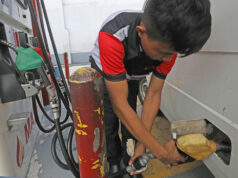DoF sees P1-trillion budget deficit, 5.3% of GDP
THE Department of Finance (DoF) is projecting a P1-trillion budget deficit this year, equivalent to about 5.3% of gross domestic product (GDP), as the spending requirements for the pandemic bring deficit norms into uncharted territory.
“What is going to be our deficit for the year? Our estimate is around a trillion pesos (P1 trillion),” Finance Secretary Carlos G. Dominguez III said in a news conference Wednesday.
Finance Undersecretary Gil S. Beltran told BusinessWorld in a mobile message that a P1-trillion deficit is equivalent to 5.3% of GDP.
Mr. Beltran also confirmed that the Development Budget Coordination Committee (DBCC) adopted the 5.3% upper limit for the deficit this year, against the 3.2% cap set before the coronavirus 2019 (COVID-19) outbreak.
In 2019, the budget deficit was P660.2 billion or 3.55% of GDP.
Mr. Beltran added that macroeconomic assumptions for the medium term are “still being formulated.”
Mr. Dominguez said the government is capable of financing such a deficit because of the Philippines’ strong fiscal position.
He also said there are no plans to ask Congress for a supplemental budget this year despite rising expenditures.
“We will strive to live with the P4.1-trillion budget this year and so far we’ve been okay with that. It has been difficult because we have to reallocate from past priorities to new priorities but that’s the reality of the situation,” Mr. Dominguez said, adding that the economic team is reviewing the budget plan for 2021.
The government plans to borrow around $5.7 billion from multilateral agencies including the World Bank, the Asian Development Bank (ADB) and the Asian Infrastructure Investment Bank (AIIB).
Mr. Dominguez said the Department of Finance (DoF) will continue negotiating for project-based bilateral financing agreements committed by Japan, South Korea and China.
“In fact, there is also bilateral financing available from France, of I think $200-300 million,” he said.
Finance Undersecretary Mark Dennis Y.C. Joven, who also heads the DoF’s International Finance Group (IFG), said the group cannot disclose specific details of the agreements while negotiations are pending, saying only that the target is to obtain both project finance and budget-support facilities.
Mr. Joven noted that many countries expressed willingness to help the Philippines, “realizing that the coronavirus pandemic is a global problem and not limited by borders.”
“We are exploring, but we’re hoping that some of these (agreements) will mature this year,” Mr. Joven said in a phone interview Wednesday.
So far, multilateral lenders have approved a total of $2.1 billion worth of loans for use in the COVID-19 containment effort — $1.5 from the ADB and $600 million from the World Bank.
The government is seeking another $750 million from the AIIB to confinance programs with the ADB.
STIMULUS PACKAGE
Mr. Dominguez said the DBCC has also approved the outline for a stimulus package that will be discussed with Congress this week.
“We have prepared the outline of the economic stimulus package which has been approved by the DBCC. We will discuss this at length with the legislature, tomorrow or Friday, so that we can come up with a really responsive and responsible stimulus package,” he said.
Mr. Dominguez said the package will consist of three parts: direct support for the vulnerable population; the recovery plan for the economy; and measures that will “sustain and keep (the country) healthy” after the pandemic ends.
He said the recovery component will include “assistance to banks who support their clients and job creation,” which will involve measures to be implemented by the central bank.
Several stimulus package bills are being drafted by members of the House of Representatives including the proposed P1.3-trillion Philippine Economic Stimulus Act (PESA) bill.
NEDA Acting Director-General Karl Kendrick T. Chua said in a text message that the size of the stimulus package will be determined after the economic managers’ meeting with the legislators. — Beatrice M. Laforga



